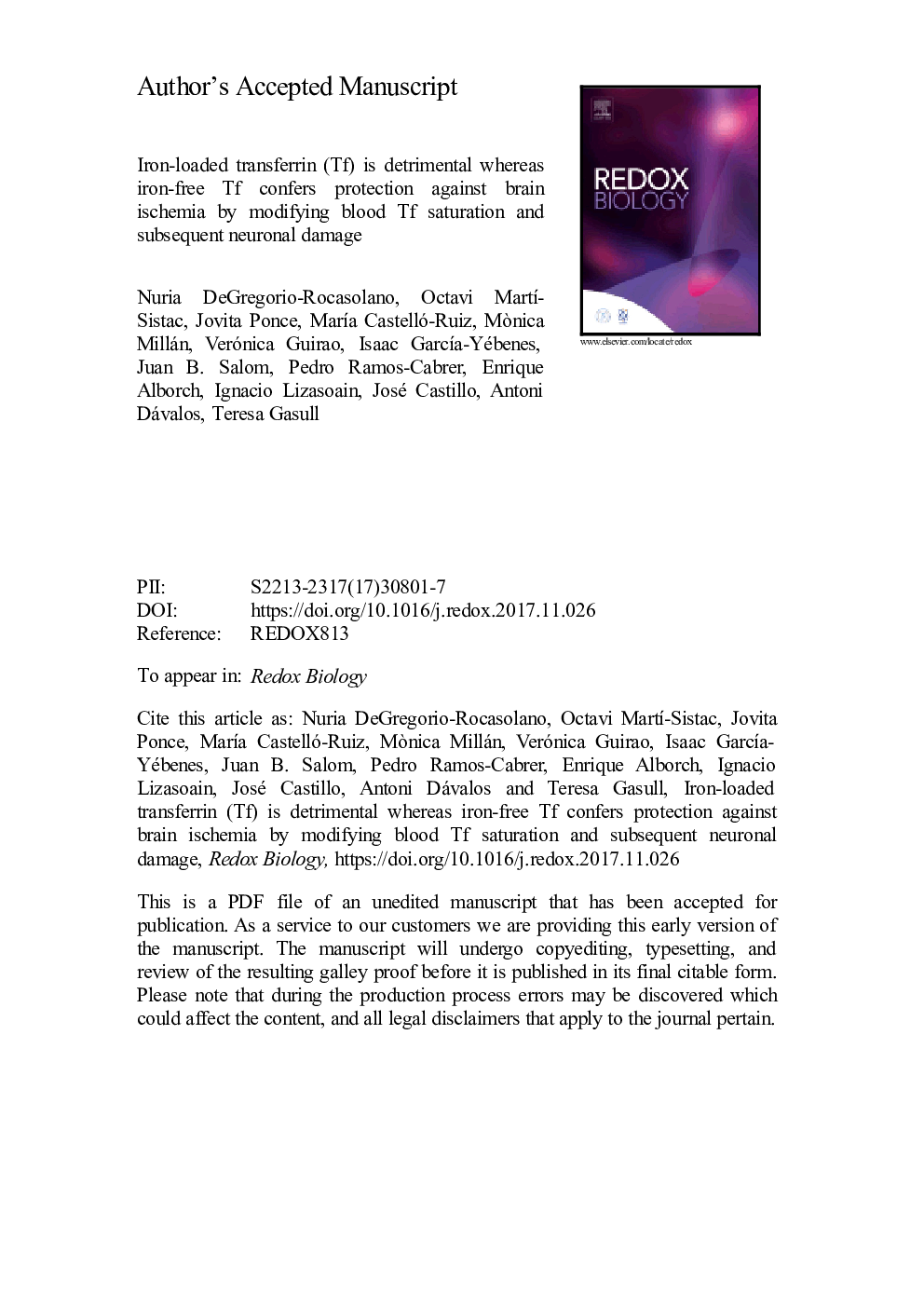| کد مقاله | کد نشریه | سال انتشار | مقاله انگلیسی | نسخه تمام متن |
|---|---|---|---|---|
| 8286567 | 1535835 | 2018 | 49 صفحه PDF | دانلود رایگان |
عنوان انگلیسی مقاله ISI
Iron-loaded transferrin (Tf) is detrimental whereas iron-free Tf confers protection against brain ischemia by modifying blood Tf saturation and subsequent neuronal damage
دانلود مقاله + سفارش ترجمه
دانلود مقاله ISI انگلیسی
رایگان برای ایرانیان
کلمات کلیدی
HTFMCAON-methyl-d-aspartateNMDAOGDDWINMDAR2,3,5-triphenyl-tetrazolium chlorideTTCpMCAOTMCAOPWIATFPC12WGADcfapotransferrinADCTransferrinTFRNIR4-hydroxynonenal4-HNETSATMCACM-H2DCFDADMT-1DihydrofluoresceinROS - ROSMRI - امآرآی یا تصویرسازی تشدید مغناطیسیmiddle cerebral artery occlusion - انسداد شریان (سرخرگ) مغزی میانیPermanent middle cerebral artery occlusion - انسداد شریان مغزی میانی دائمیtransient middle cerebral artery occlusion - انسداد شریان مغزی میانی متناوبoxygen/glucose deprivation - اکسیژن / محرومیت گلوکزPerfusion-weighted imaging - تصویربرداری با وزن متعادلdiffusion-weighted imaging - تصویربرداری با وضوح تصویربرداریMagnetic resonance imaging - تصویربرداری رزونانس مغناطیسیBBB - سد خونی مغزیExperimental Stroke - سکته تجربیConditioned medium - شرایط محیطیmiddle cerebral artery - شریان مغزی میانیBrain damage - ضربه مغزیapparent diffusion coefficient - ضریب انتشار آشکارNear infrared - مادون قرمز نزدیکBlood-brain barrier - مانع خون مغزیdivalent metal transporter - متالورژی دوقلوی فلزیNeuroprotection - محافظت نورونی یا محافظت از عصبHolotransferrin - هولوترانسفرفرینWestern blot - وسترن بلاتPropidium iodide - پروتئین یدیدReactive oxygen species (ROS) - گونه های اکسیژن واکنشی (ROS)Reactive oxygen species - گونههای فعال اکسیژنWheat germ agglutinin - گیاه گندم آگلوتیینینN-methyl-d-aspartate receptor - گیرنده N-methyl-d-aspartatetransferrin receptor - گیرنده انتقالین
موضوعات مرتبط
علوم زیستی و بیوفناوری
بیوشیمی، ژنتیک و زیست شناسی مولکولی
سالمندی
پیش نمایش صفحه اول مقاله

چکیده انگلیسی
Despite transferrin being the main circulating carrier of iron in body fluids, and iron overload conditions being known to worsen stroke outcome through reactive oxygen species (ROS)-induced damage, the contribution of blood transferrin saturation (TSAT) to stroke brain damage is unknown. The objective of this study was to obtain evidence on whether TSAT determines the impact of experimental ischemic stroke on brain damage and whether iron-free transferrin (apotransferrin, ATf)-induced reduction of TSAT is neuroprotective. We found that experimental ischemic stroke promoted an early extravasation of circulating iron-loaded transferrin (holotransferrin, HTf) to the ischemic brain parenchyma. In vitro, HTf was found to boost ROS production and to be harmful to primary neuronal cultures exposed to oxygen and glucose deprivation. In stroked rats, whereas increasing TSAT with exogenous HTf was detrimental, administration of exogenous ATf and the subsequent reduction of TSAT was neuroprotective. Mechanistically, ATf did not prevent extravasation of HTf to the brain parenchyma in rats exposed to ischemic stroke. However, ATf in vitro reduced NMDA-induced neuronal uptake of HTf and also both the NMDA-mediated lipid peroxidation derived 4-HNE and the resulting neuronal death without altering Ca2+-calcineurin signaling downstream the NMDA receptor. Removal of transferrin from the culture media or blockade of transferrin receptors reduced neuronal death. Together, our data establish that blood TSAT exerts a critical role in experimental stroke-induced brain damage. In addition, our findings suggest that the protective effect of ATf at the neuronal level resides in preventing NMDA-induced HTf uptake and ROS production, which in turn reduces neuronal damage.
ناشر
Database: Elsevier - ScienceDirect (ساینس دایرکت)
Journal: Redox Biology - Volume 15, May 2018, Pages 143-158
Journal: Redox Biology - Volume 15, May 2018, Pages 143-158
نویسندگان
Nuria DeGregorio-Rocasolano, Octavi MartÃ-Sistac, Jovita Ponce, MarÃa Castelló-Ruiz, Mònica Millán, Verónica Guirao, Isaac GarcÃa-Yébenes, Juan B. Salom, Pedro Ramos-Cabrer, Enrique Alborch, Ignacio Lizasoain, José Castillo, Antoni Dávalos,